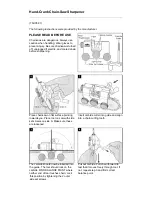
2
16574246_ed2
Product Safety Information
WARNING
Failure to observe the following warnings, and to avoid these potentially hazardous situations, could result in death or serious
injury.
Read and understand this and all other supplied manuals before installing, operating, repairing, maintaining, changing accessories
on, or working near this product.
Always wear eye protection when operating or performing maintenance on this tool. The grade of protection required should be
assessed for each use and may include impact-resistant glasses with side shields, goggles, or a full face shield over those glasses.
Always turn off the air supply, bleed the air pressure and disconnect the air supply hose when not in use, before installing, removing
or adjusting any accessory on this tool, or before performing any maintenance on this tool or any accessory.
Note:
When reading the instructions, refer to exploded diagrams in parts Information Manuals when applicable (see under Related Documentation
for form numbers).
Lubrication
•
•
•
•
Each time a “A” Series or “W” Series Chipper is
disassembled for maintenance and repair or replacement of
parts, pour about 3 cc of Ingersoll Rand No. 10 Oil in the air
inlet and operate the tool for 5 seconds to coat the internal
parts with oil.
Weekly, flush the Tool and lubricate immediately afterwards
as instructed in PLACING THE TOOL IN SERVICE.
Loss of power and excessive air consumption may be due to
wear on the Piston (22) and the bore of the Barrel (23). This
can be determined by checking the Piston diameter at each
end and in the center with a micrometer. If the diameter at the
center is .003” greater than the diameter at either end, it is
proof that the Piston and Barrel are worn. To correct, lap the
Barrel and install an oversize Piston as instructed below,
under Installation of Oversize Piston.
Oversize Parts
The Piston (22), Nozzle (24) and Inlet bushing (11) can be
furnished oversize as well as standard size. When properly
installed, oversize parts renew the efficiency of the Chipper
as well as lengthen its life. See Installation of Oversize
Piston, Nozzle, and Inlet Bushing on Page 22.
If examination of the Handle (1) indicates that it is not seating
squarely on the Valve Cap (17), reface the handle seat. Coat
the barrel threads with graphite grease or other rust resisting
compound before screwing on the Handle.
Disassembly
General Instructions
Do not disassemble the tool any further than necessary to replace
or repair damaged parts.
Whenever grasping a tool or part in a vise, always use leather-
covered or copper-covered vise jaws to protect the surface of
the part and help prevent distortion. This is particularly true of
threaded members and housings.
Do not remove any part which is a press fit in or on a subassembly
unless the removal of that part is necessary for repairs or
replacement.
Do not disassemble the tools unless you have a complete set of
new gaskets and O-rings for replacement.
Disassembly of Handle and Throttle Mechanism
Remove the Lock Spring (33A) or Flat Spring and Pin (33B) and
Retainer (33).
Using a vise with leather-covered or copper-covered jaws, clamp
the Chipper by the Barrel (23) with the Handle (1) up.
Using a pin punch, drive the Throttle Lever Pin (3) from the
Handle. Remove the Throttle Lever (2).
Unscrew the Throttle Valve Cap (9) and remove the Throttle Valve
1.
2.
3.
4.
1.
2.
3.
4.
Spring (8), Throttle Valve Ball (5) and Throttle Valve Plunger (6).
To remove the Throttle Valve Bushing (7), tap the Bushing to
a 9/16”-12 thread. Thread a 9/16”-12 thread cap screw into
the Bushing, grasp the head of the screw in a vise and pull the
Bushing from the Handle.
Unscrew and remove the Inlet bushing (11).
Disassembly of the Barrel, Piston and Nozzle
Using the No. 34SR-54 Exhaust Deflector Pliers, Spread apart the
Exhaust Deflector (21) and let it slide down the Barrel.
Using a screwdriver and hammer, tap Lock Ring (20) until it
disengages from the castellations on the Handle and slides free of
the splines on the Barrel.
Unscrew the Handle using a wrench at least 30” (760 mm) long.
Remove Valve Assembly from top of Barrel and disassemble by
removing Dowel Pins (19).
Remove Barrel from vise, remove Deflector and Ring from Barrel
and while holding it over a bench, tip large end down to allow
Piston (22) to slide out.
To remove Nozzle (24), use the No. H02-119 Nozzle Ejection Arbor,
support the end of the Barrel and press out old Nozzle.
5.
6.
1.
2.
3.
4.
5.
6.
Assembly
General Instructions
Whenever grasping a tool or part in a vise, always use leather-
covered or copper-covered vise jaws. Take extra care with
threaded parts and housings.
Always clean every part and wipe every part with a thin film of oil
before installation.
Apply a film of O-ring lubricant to all O-rings before final
assembly.
Assembly of the Barrel, Piston and Valve
Secure the Barrel (23) in a vise with leather-covered or copper-
covered jaws with large or threaded end up.
Install Piston (22), small end first, in Barrel.
1.
2.
3.
1.
2.
Assemble Valve components in the following sequence: Valve
Seat (16), Valve (15), Valve Spacer (18) and Valve Cap (17). Align
holes in Valve, Valve Seat and Valve Cap and install Dowel Pins
(19).
Place assembled Valve components on large or threaded end of
Barrel with Valve Seat down.
Install Handle (1) and tighten to 180 ft-lb (244 Nm)
torque.
Assembly of the Handle, Throttle Mechanism and
Nozzle
Install the Air Strainer Body (11) in the Handle.
Slide the new Throttle Valve Plunger Bushing (7) over a plunger
3.
4.
5.
6.
1.
2.






















